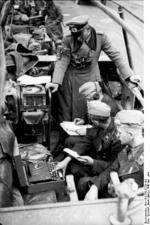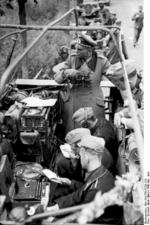Enigma Machine Communications
| Country of Origin | Germany |
| Type | Communications |
Contributor: Alan Chanter
ww2dbaseResembling in shape and size an expanded electric typewriter the Enigma machine was used by the German armed forces extensively for enciphering wartime communications. For a device designed to generate many millions of unintelligible cipher text the Enigma machine was of a remarkably attractive construction made from wood, brass and Bakelite. It came in an unprepossessing square wooden case that could be very quickly packed up for portability.The first cipher motor machine was invented in 1918 and patented by German electrical engineer Dr. Arthur Scherbius (1878-1929). Dutch inventors Theo van Hengel (1875-1939) and Rudolf Spengler (1875-1955) had devised something similar some years before, but Scherbius had been the first to make it work. The first British contact with the machine came in 1921, while it was still in development. It was shown to the British Military Attaché in Berlin, in the hope of persuading the British armed forces to use it. Then, in 1923, Dr. Scherbius presented it at the International Postal Union Congress in Switzerland for use by banks and other commercial organisations which needed to keep data confidential.
Although Dr. Scherbius's invention initially received little enthusiasm from the banking industry, its potential for encoding messages soon attracted the attention of the German Navy who obtained it in 1926, followed similarly by the German Army in 1928. While the German military bought up the exclusive rights to Enigma, it was, actually, licensed to a few other nations, notably Switzerland and Hungary. Also a commercial model was made available, one of which was purchased by British codebreaker Dilwyn "Dilly" Knox (q.v.) in Vienna, Austria in 1926. This was examined by the Government Code and Cipher School, in the shape of Hugh Foss (who was later to play a leading role at Bletchley Park). He concluded that Enigma would not be especially difficult to break, and therefore was not considered worthy of their use. Although the British decided not to buy the machine, the Royal Air Force did use it as the inspiration for a much more secure rotor-based cypher machine known as Type-X which British armed forces used with great success during the Second World War.
The Enigma machine consisted of a typewriter keyboard above which, on another board, was a set of lights corresponding with the letters of the alphabet. Inside there were three concentrically arranged teethed brass rotors or wheels, each of which had the alphabet marked on it twice, on the inside and on the outside. Each outside letter contained electrical contacts around the circumference, one for every letter of the alphabet. Each rotor had different numbered ring scales for each of the various German Armed Forces and these could be set to any one of twenty-six different ring settings creating numerous variations of the codes. The settings were changed daily at midnight. These contacts and their wiring were different for each of the three wheels, which could also be placed in different orders within the machine to provide a complex yet consistent substitutions for each letter as it was entered on the keyboard to further frustrate anyone trying to break the cypher.
Unlike other encoding methods which typically relied upon a simple letter substitution which could be broken because commonly used letters such as "E" might be easily spotted through their frequency of use, Enigma eliminated this drawback by producing millions of combinations to frustrate any codebreaker. Moreover no Enigma letter could ever be encrypted as itself. The German Army, Navy, Air Force and the Foreign Office, for instance, all used different configurations of the daily cipher settings for the thousands of signals which covered every aspect of combat, supply and administration. Naturally, from time to time, Allied codebreakers were able to break a particular cipher to unravel a small part of the "jigsaw" of enemy intentions (In fact Dilly Knox, on 24 April 1937, had managed to break the basic non-steckered machine supplied by the Germans to its Italian and Spanish allies during the Spanish Civil War). An advanced machine introduced in 1938 had four rotors which made Enigma even more formidable. Soon a fifth, a sixth and, by the time that war was declared in September 1939, German naval intelligence was even using one containing no less than eight rotors. The addition of more rotors, naturally multiplied the possible code combinations many times over.
In order to encode a message, the operator would set the rotors in a predetermined order and position, known as the settings. He then typed each letter of the message into the machine. The action of pressing the key sent an electrical impulse through the machine which moved a rotor individually to substitute a different letter. As each letter was typed in the first rotor moved forward one position. After that rotor had moved a certain number of times, the second rotor moved forward once, and after the second rotor had moved a number of times, the third rotor moved once. As a result, the code was constantly changing with every letter. The operator simply noted down the encoded letter as it was illuminated from beneath and displayed on the lamp board. This action would be repeated until the whole message had been enciphered. The Germans also added a Stecker plug-board to provide an additional level of security. This looked like a miniature telephone switchboard containing small plug holes where cables and jacks were used to connect pairs of letters to increase the possible encoding combinations by many millions. These plug board settings were also changed daily. The machine did not actually print anything out, nor did it send the message itself. The completed encoded message would be sent via normal wireless transmission, usually using Morse code. When the coded message was received at its intended destination a recipient operator, using duplicate daily settings, would reverse the entire procedure. By typing in the encrypted letters on his own Enigma the lamp board would light up with the decoded letters thereby allowing the message to be read.
The German Military High Command (OKW) believed that with Enigma they had such a secure encryption system that it would be impossible for their codes to be broken. In this they would be quite mistaken. For although breaking into the codes was extremely difficult they had failed to reckon with the brilliant academics at Britain's Bletchley Park. British (and later American) codebreakers eventually solved the mysteries of the German system and by the end of the war were frequently able to secretly read thousands of enemy messages daily, and often before the Germans could themselves.
Sources:
Michael Kerrigan: How Bletchley Park Won World War II (Amber Books, 2018)
Michael Paterson: Voices of the Codebreakers (Greenhill Books, 2018)
Michael Smith: The Debs of Bletchley Park (Aurum Press, 2015)
Michael Smith: The Secrets of Station X (Biteback Publishing, 2011)
Katherine Marsh (Editor): Story of World War II (Future Publishing, 2018)
Sinclair McKay: Bletchley Park - The Secret Archives (Aurum Press, 2016) ww2dbase
Last Major Revision: Jan 2020
Photographs
 |  |  |  |
Please consider supporting us on Patreon. Even $1 per month will go a long way! Thank you. Please help us spread the word: Stay updated with WW2DB: |
Visitor Submitted Comments
All visitor submitted comments are opinions of those making the submissions and do not reflect views of WW2DB.
Search WW2DB

News
- » Evergreen Museum and Obon Society Working on Returning Undelivered 1945 Mail to Japanese Families (5 Sep 2025)
- » Wreck of Teruzuki Found (27 Jul 2025)
- » USS Orlean's Bow Found (22 Jul 2025)
- » The Emperor of Japan Planned to Honor WW2-era Japanese POWs in Mongolia (4 Jul 2025)
- » US State Lawmaker John Winter Caught Using Racial Slur "Jap" and Apologized (11 Jun 2025)
- » See all news
Current Site Statistics
- » 1,182 biographies
- » 337 events
- » 45,131 timeline entries
- » 1,249 ships
- » 350 aircraft models
- » 207 vehicle models
- » 376 weapon models
- » 123 historical documents
- » 261 facilities
- » 471 book reviews
- » 28,432 photos
- » 365 maps
Famous WW2 Quote
"Never in the field of human conflict was so much owed by so many to so few."Winston Churchill, on the RAF
Support Us
Please consider supporting us on Patreon. Even $1 a month will go a long way. Thank you!
Or, please support us by purchasing some WW2DB merchandise at TeeSpring, Thank you!
7 May 2022 12:49:37 PM
Enigma was broken by Polish mathematicians from Poznań, and it was on their work that the Allies based. It is a pity that you always forget that Poland was not a minor Allied power, but an arena of many decisive events in the face of this war. Americans have a strange memory. They declare friendship, but at the same time forget e.g. The role of Poland in World War II.
Poland was the only country in which there was a regular underground army, the only country in which death was punished for helping Jews. Polish soldiers fought on almost every front of the Second World War. Both alongside the Red Army on the Eastern Front, in the skies of England, Monte Casino, in Operation Market Garden... Don't forget that...